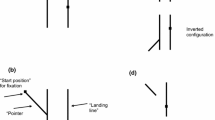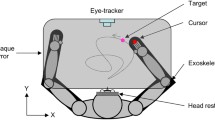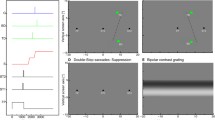Abstract
This experiment tested whether the perceived stability of the environment is altered when there is a combination of eye and visually open-loop hand movements toward a target displaced during the eye movements, i.e., during saccadic suppression. Visual-target eccentricity randomly decreased or increased during eye movements and subjects reported whether they perceived a target displacement or not, and if so, the direction of the displacement. Three experimental conditions, involving different combinations of eye and arm movements, were tested: (a) eye movements only; (b) simultaneous eye and rapid arm movements toward the target; and (c) simultaneous eye and arm movements with a restraint blocking the arm as soon as the hand left the starting position. The perceptual threshold of target displacements resulting in an increased target eccentricity was greater when subjects combined eye and arm movements toward the target object, specially for the no-restraint condition. Subjects corrected most of their arm trajectory toward the displaced target despite the short movement times (average MT = 189 ms). After the movements, the null error feedback of the hand's final position presumably overlapped the retino-oculomotor signal error and could be responsible for the deficient perception of target displacements. Thus, subjects interpreted the terminal hand positions as being within the range of the endpoint variability associated with the production of rapid arm movements rather than as a change of the environment. These results suggest that a natural strategy adopted for processing spatial information, especially in a competing situation, could favour a constancy tendency, avoiding systematic perception of a change of environment for any noise or variability at the central or peripheral levels.
Similar content being viewed by others
References
Alstermark, B., Eide, E., Gorska, T., Lundberg, A., & Pettersson, L. G. (1984). Visually guided switching of forelimb target reaching in cats. Acting Physiologica Scandinavica, 120, 151–153.
Alstermark, B., Gorska, T., Lundberg, A., Pettersson, L. G., & Walkowska, M. (1987). Effect of different spinal cord lesions on visually guided switching of target-reaching cats. Neuroscience Research, 5, 63–67.
Becker, W. (1972). The control of eye movements in the saccadic system. Bibliotheca Ophtalmologica, 82, 233–243.
Becker, W. (1989). Metrics. In R. H. Wurtz & M. E. Goldberg (Eds.), The neurobiology of saccadic eye movements (pp. 13–68). Oxford: Elsevier.
Biguer, B., Jeannerod, M., & Prablanc, C. (1982). The coordination of eye, head and arm movements during reaching at a single visual target. Experimental Brain Research, 46, 301–304.
Blouin, J., Bard, C., Teasdale, N., Paillard, J., Fleury, M., Forget, R., & Lamarre, Y. (1993). Reference systems for coding spatial information in normal subjects and a deafferented patient. Experimental Brain Research, 93, 324–332.
Blouin, J., Bard, C., Teasdale, N., & Fleury, M. (1993). On-line versus off-line control of rapid arm aiming movements. Journal of Motor Behavior, 25, 275–279.
Blouin, J., Teasdale, N., Bard, C., & Fleury, M. (1993). Directional control of rapid arm movements: the role of the visual kinetic feedback system. Canadian Journal of Experimental Psychology, 47, 678–696.
Blouin, J., Teasdale, N., Bard, C., & Fleury, M. Control of rapid goal-directed arm movements when target position is altered during the saccadic suppression. Journal of Motor Behavior, in press.
Bridgeman, B., van der Heijden, A. H. C., & Velichkovsky, B. M. (1994). A theory of visual stability across saccadic eye movements. Behavioral and Brain Sciences, 17, 247–258.
Bridgeman, B., & Fisher, B. (1990). Saccadic suppression of displacement is stronger in central vision. Perception, 19, 102–111.
Bridgeman, B., & Stark, L. (1979). Omnidirectional incrase in threshold for image shifts during saccadic eye movements. Perception & Psychophysics, 25, 241–243.
Bridgeman, B., Hendry, D., & Stark, L. (1975). Failure to detect displacement of the visual world during saccadic eye movements. Vision Research, 15, 719–722.
Bridgeman, B., Lewis, S., Heit, G., & Nagle, M. (1979). Relation between cognitive and motor-oriented systems of visual position perception. Journal of Experimental Psychology: Human Perception and Performance, 5, 692–700.
Cooke, J. D., & Diggles, V. A. (1984). Rapid error correction during human arm movements: evidence for central monitoring. Journal of Motor Behavior, 16, 348–363.
Coren, S. (1986). An efferent component in the visual perception of direction and extent. Psychological Review, 93, 391–410.
Deubel, H., Wolf, W.,& Hauske, G. (1982). Corrective saccades: effects of shifting the saccade goal. Vision Research, 22, 353–364.
Festinger, L., & Canon, L. K. (1965). Information about spatial location based on knowledge about efference. Psychological Review, 72, 373–384.
Fleury, M., Bard, C., Audiffren, M., Teasdale, N., & Blouin, J. (1994). The attentional cost of amplitude and directional requirements when pointing to targets. Quarterly Journal of Experimental Psychology: Human Experimental Psychology, 47A, 481–495.
Gandevia, S. C., & Burke, D. (1992). Does the nervous system depend on kinesthetic information to control natural limb movements. Behavioral and Brain Sciences, 15, 614–632.
Gauthier, G. M., Vercher, J. -L., Mussa Ivaldi, F., & Marchetti, E. (1988). Oculo-manual tracking of visual targets: control learning, coordination control and coordination model. Experimental Brain Research, 73, 127–137.
Ghez, C., Hening, W., & Favilla, M. (1989). Gradual specification of response amplitude in human tracking performance. Brain, Behavorial and Evolution, 33, 69–74.
Gielen, C. C. A. M., van den Heuvel, P. J. M., & van Gisbergen, J. A. M. (1984). Coordination of fast eye and arm movements in a tracking task. Experimental Brain Research, 56, 154–161.
Henson, D. B. (1977). Corrective saccades; effect of altering visual feedback. Vision Research, 18, 63–67.
Jakobson, L. S., & Goodale, M. A. (1989). Trajectories of reaches to prismatically-displaced targets: Evidence for “automatic” visuomotor recalibration. Experimental Brain Research, 78, 575–587.
McCloskey, D. I., Colebatch, J. G., Potter, E. K., & Burke, D. (1983). Judgements about onset of rapid voluntary movements in man. Journal of Neurophysiology, 49, 851–863.
MacKay, D. (1970). Elevation of visual threshold by displacement of retinal image. Nature, 225, 872–873.
Marteniuk, R. G. (1978). The role of eye and head positions in slow movement execution. In G. E. Stelmach (Ed.), Information processing in motor learning and control (pp. 267–288). New York: Academic Press.
Matin, E. (1974). Saccadic suppression: a review and an analysis. Psychological Bulletin, 81, 899–917.
Nemire, K., & Bridgeman, B. (1987). Oculomotor and skeletal motor systems share one map of visual space. Vision Research, 27. 393–400.
Paillard, J. (1990). Reactif et prédictif: deux modes de gestion de la motricité. In V. Nougier & J. P. Blanchi (Eds.), Pratiques sportives et modélisation du geste (pp. 13–56). Grenoble: Collection Grenoble Sciences.
Paulignan, Y., Mackenzie, C., Marteniuk, R., & Jeannerod, M. (1991). Selective perturbation of visual input during prehension movements. 1. The effects of changing object position. Experimental Brain Research, 83, 502–512.
Pélisson, D., Prablanc, C., Goodale, M. A., & Jeannerod, M. (1986). Visual control of reaching movements without vision of the limb. 11. Evidence of fast unconscious processes correcting trajectory of the hand to final position of a double step stimulus. Experimental Brain Research, 62, 303–311.
Prablanc, C., Echallier, J. F., Komilis, E., & Jeannerod, M. (1979). Optimal response of eye and hand motor systems in pointing at a visual target. II. Static and dynamic visual cues in the control of hand movements. Biological Cybernetics, 35, 183–187.
Prablanc, C., & Jeannerod, M. (1975). Corrective saccades: dependence on retinal reafferent signals. Vision Research, 15, 465–469.
Prablanc, C., & Martin, O. (1992). Automatic control during hand reaching at undetected two-dimensional target displacements. Journal of Neurophysiology, 67, 455–469.
Redding, G. M., & Wallace, B. (1990). Effects on prism adaptation of duration and timing of visual feedback during pointing. Journal of Motor Behavior, 22, 209–224.
Smith, A. M., & Humphrey, D. R. (1991). Group report: what do studies of specific motor acts such as reaching and grasping tell us about the general principles of goal-directed motor behavior. In D. R. Humphrey & H. -J. Freund (Eds.), Motor control: Concepts and issues (357–381). New York: John Wiley & Sons.
Stark, L., Kong, R., Schwartz, S., Hendry, D., & Bridgeman, B. (1976). Saccadic suppression of image displacement. Vision Research, 16, 1185–1187.
Vercher, J. -L., & Gauthier, G. M. (1992). Oculo-manual coordination control: ocular and manual tracking of visual targets with delayed visual feedback of the hand motion. Experimental Brain Research, 90, 599–609.
Weber, R. B., & Daroff, R. B. (1971). The metrics of horizontal saccadic eye movements in normal humans. Vision Research, 11, 921–928.
Weber, R. B., & Daroff, R. B. (1972). Corrective movements following refixation saccades: type and control system analysis. Vision Research, 12, 467–475.
Welch, R. B., & Warren, D. H. (1980). Immediate perceptual response to intersensory discrepancy. Psychological Bulletin, 88, 638–667.
Wertheim, A. H. (1994). Motion perception during self-motion. The direct versus inferential controversy revisited. Behavioral and Brain Sciences, 17, 293–311.
Whipple, W. R., & Wallach, H. (1978). Direction-specific motion thresholds for abnormal image shifts during saccadic eye movement. Perception & Psychophysics, 24, 349–355.
Author information
Authors and Affiliations
Corresponding author
Rights and permissions
About this article
Cite this article
Blouin, J., Bridgeman, B., Teasdale, N. et al. Visual stability with goal-directed eye and arm movements toward a target displaced during saccadic suppression. Psychol. Res 58, 169–176 (1995). https://doi.org/10.1007/BF00419632
Received:
Accepted:
Issue Date:
DOI: https://doi.org/10.1007/BF00419632




